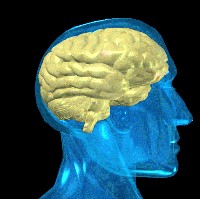A team led by a computational physicist and neuroscientist at Children’s Hospital Boston in Massachusetts have devised a technology that can lead to noninvasive tests for evaluating the risk of autism in infants. Their findings appear today in the journal BMC Medicine.
The technology combines the standard electroencephalogram (EEG), which records electrical activity in the brain, with machine-learning algorithms. In a pilot study, their system had 80 percent accuracy in distinguishing between nine-month-old infants known to be at high risk for autism from controls of the same age.
William Bosl, a neuroinformatics researcher at Children’s Hospital Boston, and Charles Nelson, Research Director of the Developmental Medicine Center, and colleagues, recorded resting EEG signals from 79 babies, 6 to 24 months of age, participating in a larger study aimed at finding very early risk markers of autism. Some 46 infants had an older sibling with a confirmed diagnosis of an autism spectrum disorder (ASD); the other 33 infants had no family history of ASDs.
As the babies watched a research assistant blowing bubbles, recordings were made via a hairnet-like cap on their scalps, studded with 64 electrodes. When possible, tests were repeated at 6, 9, 12, 18 and 24 months of age.
Bosl then took the EEG brain-wave readings for each electrode and computed a modified form of a measure called multiscale entropy. The measure, borrowed from chaos theory, quantifies the degree of randomness in a signal, from which characteristics of whatever is producing the signal can be inferred.
In the case of autism, patterns in the brain’s electrical activity can give indirect information about how the brain is wired. The patterns can highlight, in particular, the density of neurons in each part of the brain — the way connections between the neurons are organized — and the balance of short- and long-distance connections.
The investigators looked at the entropy of each EEG channel, which is believed to contain information about the density of neural connections in the brain region near that electrode. On average, the greatest difference was seen at nine months of age. The researchers note that at nine months, babies undergo important changes in their brain function that are critical for the emergence of higher-level social and communication skills. These skills are often impaired in autism spectrum disorders.
Overall, the distinction between the high-risk group and controls was smaller when infants were tested at 12 to 24 months. And, for reasons that still need to be explored, there was a gender difference. The researchers found that classification accuracy was greatest for girls at 6 months and remained high for boys at 12 and 18 months.
Although this work still requires further validation and refinement, it suggests a safe, practical way of identifying infants at high risk for developing autism by capturing very early differences in brain organization and function. A test of this kind would allow parents to begin behavioral interventions one to two years before autism can be diagnosed through traditional behavioral testing.
Read more:
* * *


 RSS - Posts
RSS - Posts
[…] This post was mentioned on Twitter by irenelevine, Alan Kotok. Alan Kotok said: Neuroscience, Computational Physics Help Diagnose Autism | #Science #Business http://t.co/azf6XjJ #ScienceBusiness […]
[…] Read more: Neuroscience, Computational Physics Help Diagnose Autism […]